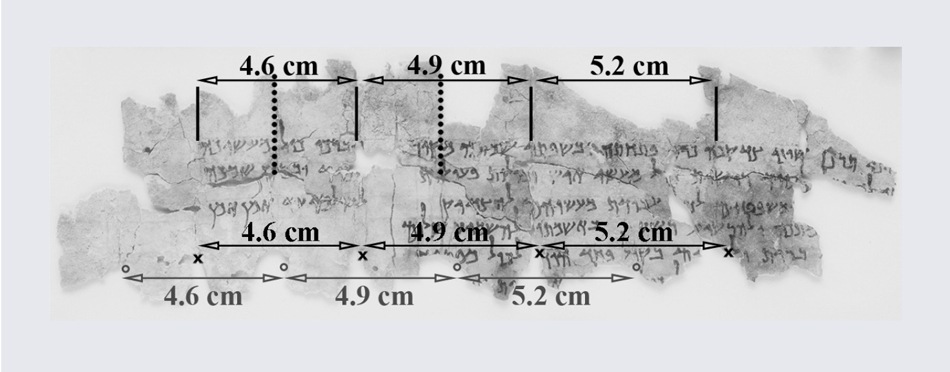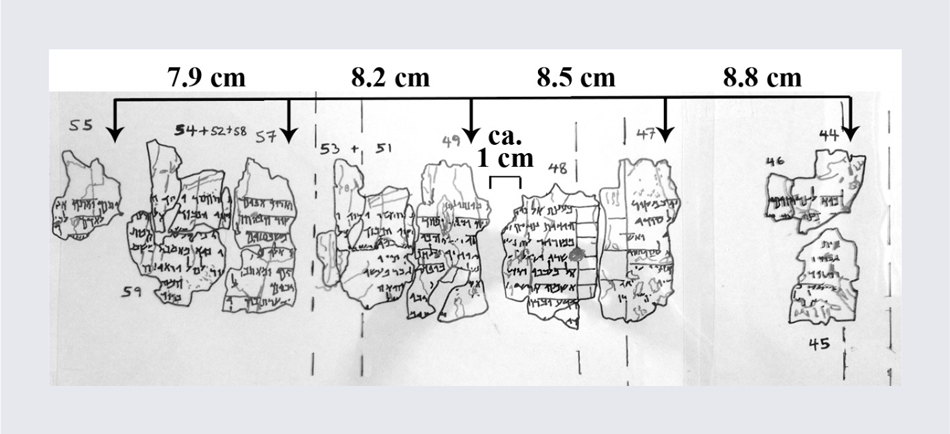The visual image that most people have of the Dead Sea Scrolls is likely of one of the beautifully preserved manuscripts stored in stone jars, discovered in the hill caves of Jordan in the late 1940s. Unfortunately, only a handful of the scrolls were preserved in this way. Most of the manuscripts recovered from the eleven caves of Khirbet Qumran had been stored loose on wooden shelves, which eventually collapsed, piling the scrolls onto the floors of the caves. Over the centuries moisture from the floors, falling debris from the ceilings of the caves, and other damage from rodents and insects meant that most of what we refer to as the “Dead Sea Scrolls” should more properly be described as the Dead Sea fragments of scrolls. What was finally recovered from the Bedouin explorers and the archaeologists in the late 1940s and early 1950s consisted of over 15,000 detached fragments from approximately a thousand different manuscripts. Because many of the finds came from Bedouin collecting activities, they were not properly excavated and were sold to authorities without information about how they had been found in situ. As one recent scholar characterized the problem, it was like receiving eleven jigsaw puzzles, with 95 percent of the pieces missing and no picture on the cover to tell you how to put the puzzles together.
Scholars are a foolhardy lot, however, and the original six members of the international team were uncommonly gifted not only with linguistic and historical knowledge but also with acute visual perception and memory. Since scribes in antiquity had handwriting that was as distinct as handwriting is today, the team was able to sort the piles of fragments into lots that represented the work of an individual scribe. Although in a few cases a single scribe had copied several manuscripts that had to be sorted according to content, in most cases the scribal hand represented a distinct manuscript.
Once that work was done, the team attempted to use jigsaw puzzle techniques to make as many direct joins as possible. Many of the photographs that one sees in publications today representing “a” fragment from one of the scrolls are actually painstaking compilations of many small fragments into contiguous joins. By the mid-1950s it appeared that the Humpty-Dumpty of the scrolls had been put together about as well as could be.
Most scholars who worked on the scrolls in the early years focused solely on the content of what remained. What made the work so frustrating was that, in addition to the fact that one was often working with only a few lines of text or even a few half-lines of text in a fragment, one had no way of knowing how the many fragments related to one another. To what extent could one reconstruct the original placement of noncontiguous fragments of a manuscript? If one was dealing with a biblical text, then the preserved medieval manuscripts provided the “cover picture” for the jigsaw puzzle, and the pieces could be fitted into place – assuming, of course, that the ancient manuscript and the medieval one preserved the same text without significant alteration. And while in most cases that did prove to be the case, in some instances the ancient manuscripts were divergent, so that the medieval manuscripts could not be an exact key. But the acute problem was the non-biblical manuscripts. Most of these were texts that were entirely new to scholars. No “cover picture” existed.
Nevertheless, one of the most brilliant and legendarily colorful members of the original team, the Polish priest and scholar Josef Milik, intuited the solution to the problem already in the early 1950s. Although he did not describe his method, he realized that rolled scrolls, being spiral tubes of leather or papyrus, would exhibit mathematically related patterns of damage, whether they were damaged by moisture deterioration at the top and bottom, creating scallop patterns, or whether they were damaged by crushing from above, creating vertical or longitudinal crack patterns. The damage patterns would not only be “echoes” of each other for each successive roll of the scroll but would also be mathematically related to one another as each successive roll of the scroll grew larger or smaller. Milik never worked out his intuitions systematically, but he used them to reconstruct one of the damaged scrolls he was entrusted with publishing.
Surprisingly, other scholars did not seem to recognize the significance of his insights. Only a German graduate student in the early 1960s, Hartmut Stegemann, grasped the importance of Milik’s perception. He systematized Milik’s insights, worked out the mathematical formulae that accounted for the thickness of the leather and how tightly or loosely a manuscript might have been rolled – whether it was rolled from the outside in or from the inside out and other variables – and began to apply this approach to additional manuscripts. Already in his dissertation in 1963 he reconstructed one of the most important of the Dead Sea Scrolls, the Hodayot (Thanksgiving Psalms). Because he was a perfectionist, however, he did not publish his work, waiting until he could resolve some lingering puzzles of the reconstruction.
Scrolls scholarship languished during the 1960s and 1970s for various reasons. But during the late 1970s Stegemann and John Strugnell of Harvard University consulted about a number of manuscripts that had been entrusted to Strugnell. Stegemann suggested that several of the manuscripts preserved sufficient physical markers to enable the kind of material reconstruction that he had pioneered. In 1978, Strugnell had assigned to me fragments of seven partially overlapping manuscripts of an apparently mystical cycle of songs that described the liturgy of angels in the heavenly temple, the Songs of the Sabbath Sacrifice. Initially, I worked on these texts as had most scholars, analyzing the fragments in isolation. While I was able to say a few things about the manuscript as a whole, my findings on the structure of the cycle were minimal when I submitted my dissertation in early 1982.
One day in the fall of 1982 I received a parcel from Germany from Hartmut Stegemann, whom I had never met. The package included his tentative reconstruction of one of the manuscripts of my Sabbath Songs. He had sent a series of taped together card-stock panels with cutout Xerox copies of fragments from my manuscripts taped on and laid out with red marker notations indicating the recurrent damage patterns on each fragment. I saw in an instant his insight into how one could use evidence from the material nature of fragments to reconstruct their relative relation to one another. It was like a reverse engineering of the paper doll chains I had made as a child. We worked together for the next two summers. When I published my work in 1985, I was able to reconstruct the sequence of the majority of the fragments from my various manuscripts and to give an account of the poetic and rhetorical structure of the document, which had been almost totally inaccessible before the reconstruction. An immense amount of “lost” information had been recovered by the application of his techniques.
In 1989, an impressive confirmation of Stegemann’s method was provided when Emile Puech, of the École Biblique in Jerusalem, published a reconstruction of the Hodayot that he had developed independently of Stegemann by using similar methods. His reconstruction was essentially identical to Stegemann’s. In the years since, the significance of Stegemann’s method has become widely recognized in Dead Sea Scrolls scholarship, and younger scholars have been turning to previously published texts of the scrolls to see if his methods could be used to reconstruct additional scroll sequences from what had been published as mere fragments. In several cases there have been such impressive results that they deserve to be recognized as a second “discovery” of the scrolls (see Figures 1 and 2).
 |
| Figure 1. Recurrent damage marks on a large fragment. Image courtesy of Joseph L. Angel and the Israel Antiquities Authority. |
 |
| Figure 2. Damage marks and scribal dry lines used to reconstruct noncontiguous fragment placement. Image courtesy of Joseph L. Angel and the Israel Antiquities Authority. |
The technique originally used – Xerox cutouts measured and pasted to mock paper scrolls – was reasonably effective but undeniably crude. The newest stage of the work, unsurprisingly, is computerized. Using newly available high resolution, multispectral digital images of the scrolls, a joint German and Israeli research project, the Scripta Qumranica Electronica project, creates online workspaces that simplify the process of taking measurements, allows the testing of proposed new joins and fragment arrangements, and evaluates the reconstructions. The tedious work of hair follicle and fiber pattern analysis for leather and papyrus scrolls will also be made much simpler. Material reconstruction of scroll fragments are, of course, just one aspect of the work of the Scripta Qumranica Electronica project. The new digital editions of the scrolls will make possible more sophisticated analysis of the contents, as well as the relation of the textual variants between the Qumran biblical scrolls and other ancient and medieval manuscripts. The project is a significant contribution to the emerging work of manuscript edition in the age of digital humanities.
The ancient scribes of Qumran – who painstakingly prepared their leather and papyrus, sewed the sheets together, dry-lined the prepared scroll, mixed their ink, and carefully copied their manuscripts – would likely be perplexed by the techniques of their latter day successors. But I think they would recognize and appreciate the same dedication to the preservation of tradition that motivated them to such effort.
Carol A. Newsom is the Charles Howard Candler Professor of Old Testament and a Senior Fellow at the Center for the Study of Law and Religion at Emory University. She was elected a Fellow of the American Academy of Arts and Sciences in 2016.
© 2017 by Carol A. Newsom